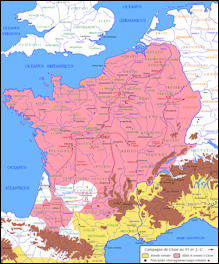

The formerly Romanized north of Gaul, once it had been occupied by the Franks, would develop into Merovingian culture instead. Into the seventh century, Gallo-Roman culture would persist particularly in the areas of Gallia Narbonensis that developed into Occitania, Cisalpine Gaul and to a lesser degree, Gallia Aquitania. Mathisen, the struggles of bishop Hilary of Arles by M. The plight of the highly Romanized governing class is examined by R.W. The Gothic settlement of 418 offered a double loyalty, as Western Roman authority disintegrated at Rome. The barbarian invasions beginning in the early fifth century forced upon Gallo-Roman culture fundamental changes in politics, in the economic underpinning, in military organization. Interpretatio romana offered Roman names for Gaulish deities such as the smith-god Gobannus, but of Celtic deities only the horse-patroness Epona penetrated Romanized cultures beyond the confines of Gaul. The well-studied meld of cultures in Gaul gives historians a model against which to compare and contrast parallel developments of Romanization in other, less-studied Roman provinces. This was characterized by the Gaulish adoption or adaptation of Roman morals and way of life in a uniquely Gaulish context. The term Gallo-Roman describes the Romanized culture of Gaul under the rule of the Roman Empire. He was considered a brave and able leader who fought against tremendous odds with remarkable success.Gallo-Roman figures found in Ingelheim am Rhein Spartacus has long served as an inspiration to those seeking to revolt against oppressive rule. Around 6,000 men survived the battle but were later captured and crucified by the Roman army. Spartacus was believed to have died in this battle.

In 71 B.C., General Marcus Licinius Crassus defeated the rebel army at Lucania, about 56 kilometers (35 miles) southeast of Naples. With each of Spartacus’ victories, however, Roman leaders started to take the group more seriously. Rome initially considered the revolt a nuisance. They marched as far north as Gaul (modern-day France). Together they used guerrilla tactics to fight off Roman attacks.Īfter about a year, the group mobilized and started traveling throughout the Roman Empire. It is estimated that there were 90,000 to 100,000 men in all. Gradually, more escaped slaves joined their ranks.
/Roman_Gaul_-_AD_400-56aaca365f9b58b7d008f778.png)
Soon after, he escaped with about 70 other gladiators and gathered his followers on nearby Mount Vesuvius. He was sent to the gladiatorial training school in Capua in 73 B.C. Spartacus was sold into slavery, perhaps due to rebellion against or desertion from the army. Though little is known about Spartacus’ early life, historians believe he may once have served in the Roman army.

Spartacus was born in Thrace, an area where the modern-day Balkans states, including Turkey, Bulgaria, and Greece, are located.


 0 kommentar(er)
0 kommentar(er)
